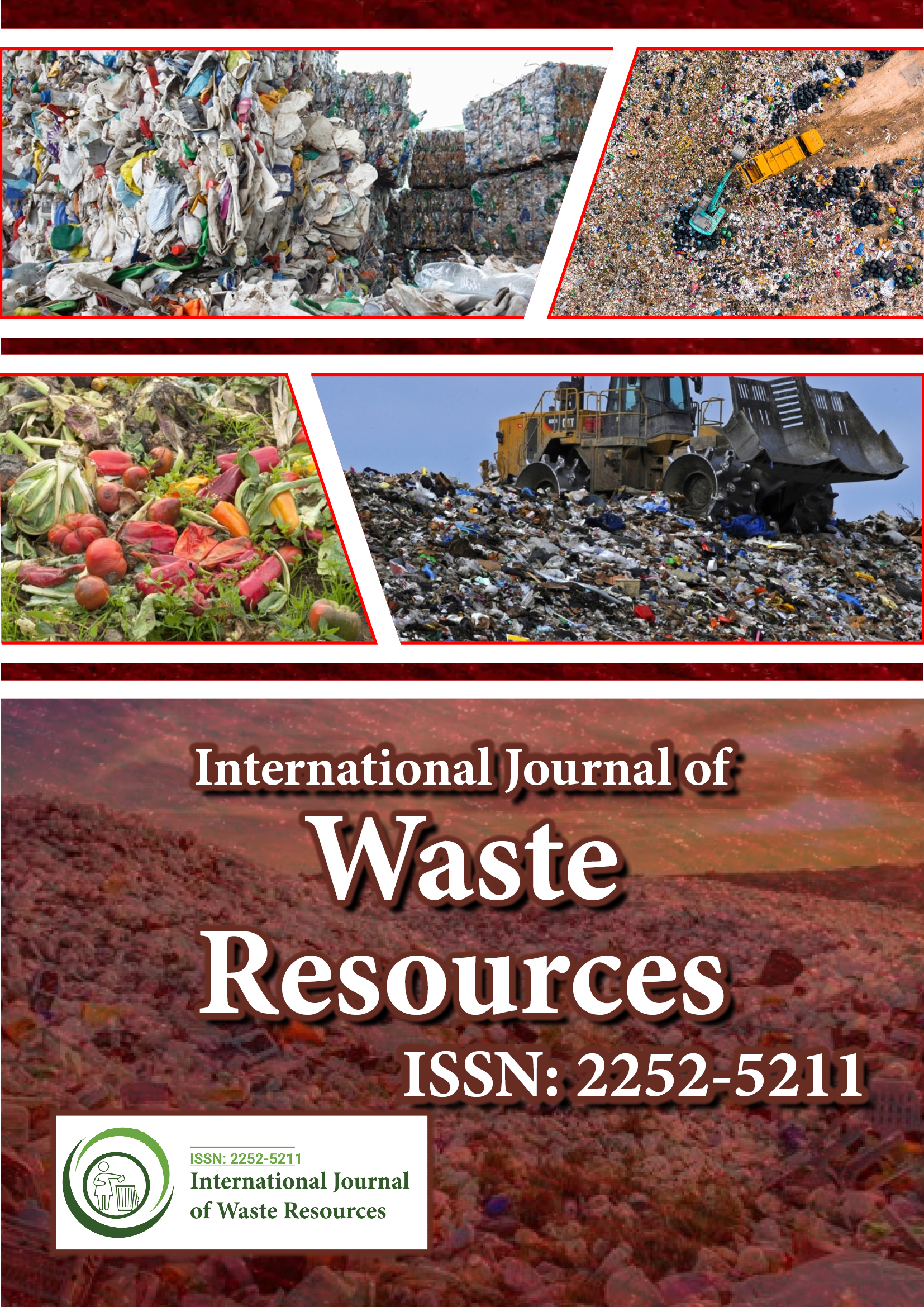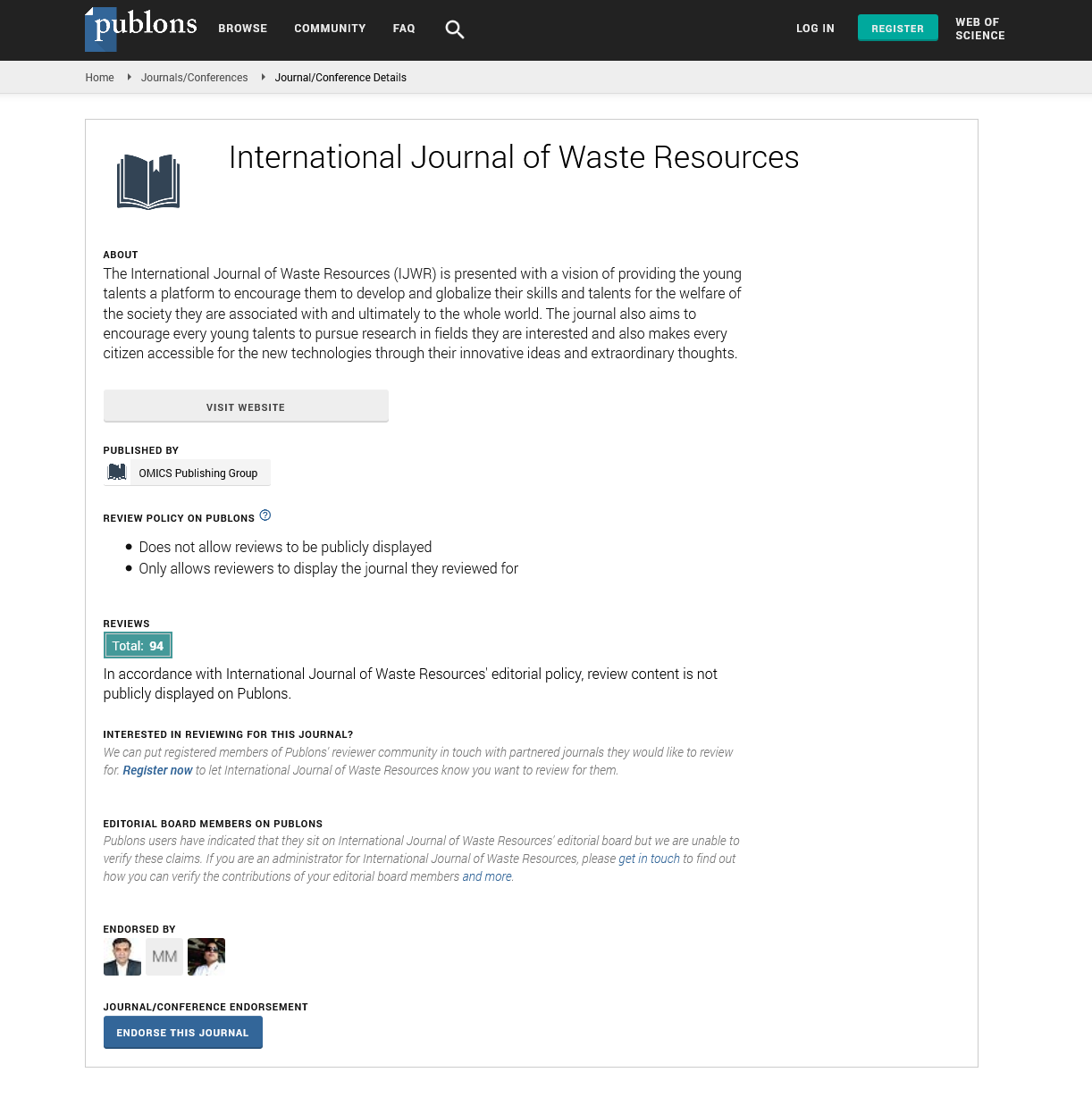Indexed In
- Open J Gate
- The Global Impact Factor (GIF)
- Open Archive Initiative
- VieSearch
- International Society of Universal Research in Sciences
- China National Knowledge Infrastructure (CNKI)
- CiteFactor
- Scimago
- Ulrich's Periodicals Directory
- Electronic Journals Library
- RefSeek
- Directory of Research Journal Indexing (DRJI)
- Hamdard University
- EBSCO A-Z
- Publons
- Google Scholar
Useful Links
Share This Page
Journal Flyer

Open Access Journals
- Agri and Aquaculture
- Biochemistry
- Bioinformatics & Systems Biology
- Business & Management
- Chemistry
- Clinical Sciences
- Engineering
- Food & Nutrition
- General Science
- Genetics & Molecular Biology
- Immunology & Microbiology
- Medical Sciences
- Neuroscience & Psychology
- Nursing & Health Care
- Pharmaceutical Sciences
Commentary - (2025) Volume 15, Issue 1
Innovative Waste Management Solutions Enabled by Advances in Science and Technology
Marvin Janele*Received: 31-Jan-2025, Manuscript No. IJWR-25-29249; Editor assigned: 03-Feb-2025, Pre QC No. IJWR-25-29249; Reviewed: 14-Feb-2025, QC No. IJWR-25-29249; Revised: 21-Feb-2025, Manuscript No. IJWR-25-29249; Published: 03-Mar-2025, DOI: 10.35248/2252-5211.25.15.603
Description
Waste management has become one of the most urgent challenges facing modern societies, driven by rapid urbanization, expanding industrial activity and accelerating population growth. Traditional disposal methods such as landfilling and open dumping are increasingly proving inadequate and environmentally unsustainable. In response, scientific advancements and technological innovations are reshaping the way waste is handled, processed and repurposed, offering smarter, more sustainable alternatives that align with global environmental and economic goals.
A foundational aspect of effective waste management lies in understanding the diverse types of waste generated by various human activities. These include municipal solid waste from households and commercial spaces, industrial waste produced during manufacturing processes, hazardous waste containing toxic or reactive substances, biomedical waste from healthcare settings that often carries infectious risks and the rapidly growing volume of electronic waste composed of discarded gadgets and appliances. The challenges posed by this complex waste stream are significant, ranging from escalating volumes and health hazards to environmental degradation and resource depletion.
Innovative technologies have brought substantial improvements to waste collection and sorting systems. The use of smart waste bins equipped with sensors allows for real-time monitoring of fill levels, enabling more efficient and cost-effective collection routes through Internet of Things (IoT) integration. Data generated by these systems helps municipalities make informed decisions and reduce fuel consumption and labor costs. Meanwhile, automated sorting technologies, powered by artificial intelligence, machine learning and robotics, are revolutionizing recycling operations. With the help of optical scanners, magnetic separators and eddy current devices, these systems are capable of identifying and separating recyclable materials with remarkable precision, greatly improving recovery rates and reducing contamination.
When it comes to treating waste, technological progress continues to unlock new possibilities. Mechanical biological treatment combines mechanical sorting with biological processes such as composting and anaerobic digestion, helping stabilize waste while recovering materials of value. Waste-to-energy technologies are also gaining prominence, with thermal processes like incineration, gasification and plasma arc treatment converting waste into usable energy forms such as electricity, heat and synthetic fuels. These methods significantly reduce the burden on landfills and help offset fossil fuel consumption. In addition, biotechnological approaches using microbial and enzyme-based treatments are enhancing the breakdown of organic waste, reducing methane emissions and producing higher-quality compost for agricultural use.
The role of science extends further into the realm of recycling and material recovery. Advances in material science have led to the creation of more recyclable polymers and biodegradable alternatives to conventional plastics. Chemical recycling techniques, which break plastics down into their original monomers, offer a pathway to reusing materials without losing quality, thus reducing the demand for virgin resources. In the realm of electronics and industrial waste, metallurgical methods are becoming increasingly sophisticated, allowing for the efficient extraction of precious and rare metals that would otherwise go to waste.
Environmental monitoring is another critical domain where technology has made a significant impact. Remote sensing tools, geographic information systems and real-time environmental sensors are used to track landfill conditions, detect pollution and assess contamination levels. These tools not only help ensure compliance with environmental regulations but also provide valuable data for health risk assessments and the development of waste management policies based on scientific modeling.
Digital platforms and data analytics are further enhancing waste management efforts. Big data technologies and block chain are helping to ensure transparency and traceability throughout the waste lifecycle. From tracking the journey of hazardous waste to optimizing logistics for recycling companies, digital tools are connecting stakeholders across the value chain and reinforcing circular economy practices. This digital transformation supports collaboration between governments, industries and communities in ways that were not previously possible.
Despite these advances, challenges persist. High initial costs for implementing advanced technologies, the need for skilled professionals to operate and maintain sophisticated systems and limited public awareness can all hinder progress. Moreover, outdated or inconsistent regulatory frameworks may slow the adoption of innovative solutions. However, the outlook remains promising. Emerging trends suggest a growing emphasis on integrating renewable energy sources into waste management processes, the development of zero-waste urban models and deeper partnerships between various sectors of society to scale up and sustain innovation.
Conclusion
In conclusion, science and technology are proving indispensable in the evolution of modern waste management. By enabling smarter collection, cleaner treatment and more effective recovery of valuable resources, these advancements are not only helping to reduce the environmental impact of waste but also contributing to long-term sustainability and resilience. Ongoing research, strategic investments and active public participation will be essential to harness the full potential of these technologies and create a cleaner, more sustainable future for all.
Citation: Janele M (2025). Innovative Waste Management Solutions Enabled by Advances in Science and Technology. Int J Waste Resour: 15:603.
Copyright: © 2025 Janele M. This is an open-access article distributed under the terms of the Creative Commons Attribution License, which permits unrestricted use, distribution and reproduction in any medium, provided the original author and source are credited.

